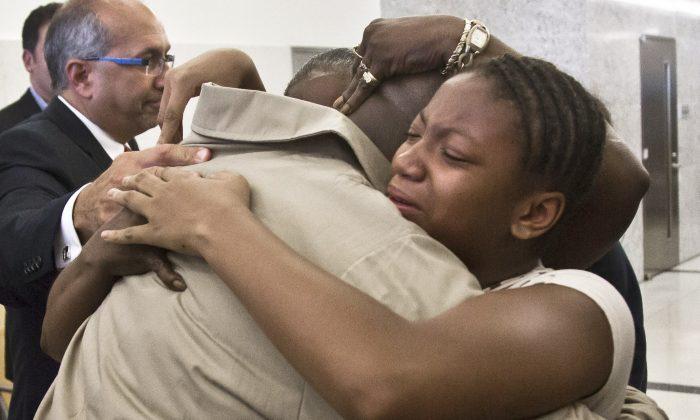David McCallum was 16 years old in 1985 when he was told by officials his friend Willie Stuckey had named him the murderer of a 20-year-old man kidnapped from Queens to Brooklyn.
McCallum then felt pressured and in turn, named Stuckey as the murderer.
The two black teenage boys were sentenced to 25 years to life in prison for the murder and kidnapping of Nathan Blenner, as well as taking Blenner’s car for a joyride.
Blenner was found shot dead in Aberdeen Park in Bushwick, Brooklyn, his wallet stolen and his car torched.
Now after serving nearly 30 years in jail, McCallum, 45, was ordered free Wednesday by Brooklyn District Attorney Kenneth Thompson’s request.
Stuckey died of a heart attack in prison in 2001.
No evidence had tied the two to the crimes, except the confessions, which were deemed false and contaminated by facts fed by police.
“After a thorough and fair review of the case by my Conviction Review Unit and the Independent Review Panel, I have concluded that their convictions should not stand,” said Thompson, referring to a group of his staff and a group of outside lawyers who review old cases.
“Mr. McCallum should be released from prison.”
McCallum shed tears, shaking, as he heard the Brooklyn Supreme Court Justice dismiss the convictions. Stuckey’s mother patted him on the back.
The re-evaluation of McCallum and Stuckey’s case comes after a decadelong fight by former prizefighter Rubin “Hurricane” Carter to get McCallum exonerated.
Carter, who got his own triple murder conviction dismissed, had learned of McCallum’s case from a letter the latter had written him.
Carter died of prostate cancer in April, but not before speaking out about McCallum’s plight to media.
According to Lupé Todd, director of communications for the Brooklyn DA, Thompson was already investigating the case when Carter reached out to him.
Whodunit
Relatives of Blenner took the news poorly.
“We were led to believe, for 29 years, that they’re the killers. They confessed,” said Nathan’s sister, Dr. Deborah Blenner.
She added that the family found it troubling that a review by district attorney staff and a panel of lawyers could overturn a jury verdict that appeals courts had upheld.
With the original suspects found innocent, the homicide case is left unsolved.
Recent DNA tests and fingerprint analyses from the stolen car matched other people, fueling questions about the case, said attorney Oscar Michelen. No one else has been charged.
Contradictions and Convictions
Brooklyn, in particular, has a bad reputation for wrongful convictions. It was named fifth in the nation with the most exonerations in a report from the National Registry of Exonerations.
About 100 other old cases are awaiting review from the Conviction Review Unit. Of the 30 people whose convictions Thompson has already looked over since the beginning of his term, 10 convictions have been dismissed and 3 of those convicted people were deceased.
McCallum and Stuckey are the 9th and 10th people whose wrongful convictions Thompson has exposed, but the first in which false confessions are the main reason for dismissal.
Thompson, who began his investigation in January, said he found contradictions all over McCallum and Stuckey’s videotaped and written statements.
In Stuckey’s confession, for example, he recalled saying, “That’s a nice car,” about a woman’s Red Buick in South Ozone Park, Queens, where Blenner lived.
The woman said that two men had been eyeballing her car, but her description of the men didn’t match Stuckey and McCallum.
Prosecutors were inconsistent, said Thompson. They took Stuckey’s confession as fact, but also said that the defendants weren’t the men the woman had encountered.
Stuckey also said there had been three gunshots—when authorities only found evidence of one gunshot to the head.
“How can we say that Stuckey’s confession was valid?” Thompson asked.
Police also didn’t find the gun where Stuckey said he'd hidden it—under his mattress—and the statements described an hourslong drive by two teenagers whom no one had ever seen drive at all, the DA noted.
The teens said the shooting happened as night fell, while medical examiners determined Blenner died around 3:15 p.m.
Last year, former Brooklyn DA Charles Hynes, whose office dealt with a 2011 lawsuit over a wrongful conviction, reviewed McCallum and Stuckey’s convictions and decided not to dismiss them.
The Associated Press contributed to this article.





Friends Read Free